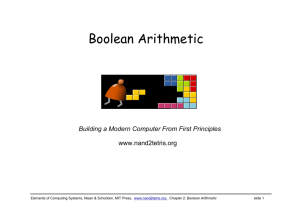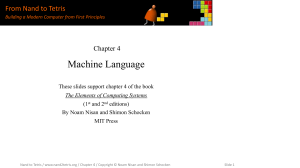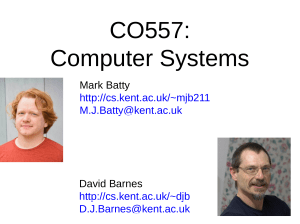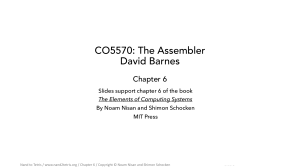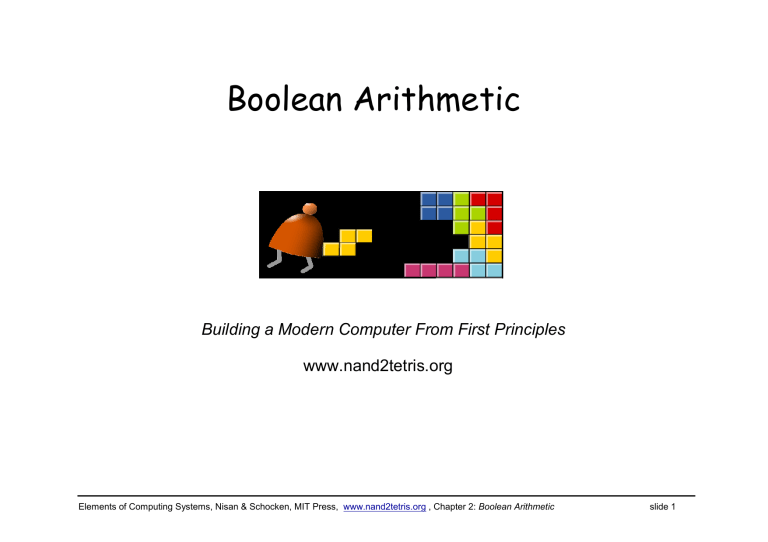
Boolean Arithmetic Building a Modern Computer From First Principles www.nand2tetris.org Elements of Computing Systems, Nisan & Schocken, MIT Press, www.nand2tetris.org , Chapter 2: Boolean Arithmetic slide 1 Counting systems quantity decimal binary 33-bit register 0 0 000 1 1 001 2 10 010 3 11 011 4 100 100 5 101 101 6 110 110 7 111 111 8 1000 overflow 9 1001 overflow 10 1010 overflow Elements of Computing Systems, Nisan & Schocken, MIT Press, www.nand2tetris.org , Chapter 2: Boolean Arithmetic slide 2 Rationale (9038) ten = 9 ⋅103 + 0 ⋅10 2 + 3 ⋅101 + 8 ⋅10 0 = 9038 (10011) two = 1 ⋅ 2 4 + 0 ⋅ 2 3 + 0 ⋅ 2 2 + 1 ⋅ 21 + 1 ⋅ 2 0 = 19 n ( xn xn−1 ...x0 ) b = ∑ xi ⋅ b i i =0 Elements of Computing Systems, Nisan & Schocken, MIT Press, www.nand2tetris.org , Chapter 2: Boolean Arithmetic slide 3 Binary addition Assuming a 4-bit system: 0 0 0 1 1 0 0 1 + 0 1 0 1 1 1 1 1 1 0 1 1+ 0 1 1 1 0 1 1 1 0 1 0 0 1 0 no overflow overflow Algorithm: exactly the same as in decimal addition Overflow (MSB carry) has to be dealt with. Elements of Computing Systems, Nisan & Schocken, MIT Press, www.nand2tetris.org , Chapter 2: Boolean Arithmetic slide 4 Representing negative numbers (4-bit system) 0 0000 1 0001 1111 -1 2 0010 1110 -2 3 0011 1101 -3 4 0100 1100 -4 5 0101 1011 -5 6 0110 1010 -6 7 0111 1001 -7 1000 -8 Example: The codes of all positive numbers begin with a “0” The codes of all negative numbers begin with a “1“ To convert a number: leave all trailing 0’s and first 1 intact, and flip all the remaining bits 2 - 5 = 2 + (-5) = 0010 +1011 1101 = -3 Elements of Computing Systems, Nisan & Schocken, MIT Press, www.nand2tetris.org , Chapter 2: Boolean Arithmetic slide 5 Building an Adder chip 16 a 16 b 1 6 -b it ad d e r 16 o ut Adder: a chip designed to add two integers Proposed implementation: Half adder: designed to add 2 bits Full adder: designed to add 3 bits Adder: designed to add two n-bit numbers. Elements of Computing Systems, Nisan & Schocken, MIT Press, www.nand2tetris.org , Chapter 2: Boolean Arithmetic slide 6 Half adder (designed to add 2 bits) sum carry a b 0 0 0 0 0 1 1 0 1 0 1 0 1 1 0 1 a b h alf ad d er s um c arry Implementation: based on two gates that you’ve seen before. Elements of Computing Systems, Nisan & Schocken, MIT Press, www.nand2tetris.org , Chapter 2: Boolean Arithmetic slide 7 Full adder (designed to add 3 bits) sum carry a b c 0 0 0 0 0 0 0 1 1 0 0 1 0 1 0 0 1 1 0 1 1 0 0 1 0 1 0 1 0 1 1 1 0 0 1 1 1 1 1 1 a s um b fu ll ad d er c arry c Implementation: can be based on half-adder gates. Elements of Computing Systems, Nisan & Schocken, MIT Press, www.nand2tetris.org , Chapter 2: Boolean Arithmetic slide 8 n-bit Adder (designed to add two 16-bit numbers) 16 a 1 6 -b it ad d e r 16 b 16 o ut ... 1 0 1 1 a … 0 0 1 0 b … 1 1 0 1 out + Implementation: array of full-adder gates. Elements of Computing Systems, Nisan & Schocken, MIT Press, www.nand2tetris.org , Chapter 2: Boolean Arithmetic slide 9 The ALU (of the Hack platform) a b s um h alf ad d er 16 a s um fu ll ad d e r b c arry 16 c arry c zx nx zy ny f x no y 16-bit adder 16 out out(x, y, control bits) = x+y, x-y, y–x, 0, 1, -1, x 16 bits ALU y out x, y, -x, -y, 16 bits x!, y!, 16 bits x+1, y+1, x-1, y-1, zr ng x&y, x|y Elements of Computing Systems, Nisan & Schocken, MIT Press, www.nand2tetris.org , Chapter 2: Boolean Arithmetic slide 10 ALU logic (Hack platform) Implementation: build a logic gate architecture that “executes” the control bit “instructions”: if zx==1 then set x to 0 (bit-wise), etc. Elements of Computing Systems, Nisan & Schocken, MIT Press, www.nand2tetris.org , Chapter 2: Boolean Arithmetic slide 11 The ALU in the CPU context (a sneak preview of the Hack platform) c1,c2, … ,c6 D D register a ALU A register A Mux RAM out A/M M (selected register) Elements of Computing Systems, Nisan & Schocken, MIT Press, www.nand2tetris.org , Chapter 2: Boolean Arithmetic slide 12 Perspective Combinational logic Our adder design is very basic: no parallelism It pays to optimize adders Our ALU is also very basic: no multiplication, no division Where is the seat of more advanced math operations? a typical hardware/software tradeoff. Elements of Computing Systems, Nisan & Schocken, MIT Press, www.nand2tetris.org , Chapter 2: Boolean Arithmetic slide 13 Historical end-note: Leibnitz (1646-1716) “The binary system may be used in place of the decimal system; express all numbers by unity and by nothing” 1679: built a mechanical calculator (+, -, *, /) CHALLENGE: “All who are occupied with the reading or writing of scientific literature have assuredly very often felt the want of a common scientific language, and regretted the great loss of time and trouble caused by the multiplicity of languages employed in scientific literature: SOLUTION: “Characteristica Universalis”: a universal, formal, and decidable language of reasoning Leibniz’s medallion for the Duke of Brunswick The dream’s end: Turing and Gödel in 1930’s. Elements of Computing Systems, Nisan & Schocken, MIT Press, www.nand2tetris.org , Chapter 2: Boolean Arithmetic slide 14
